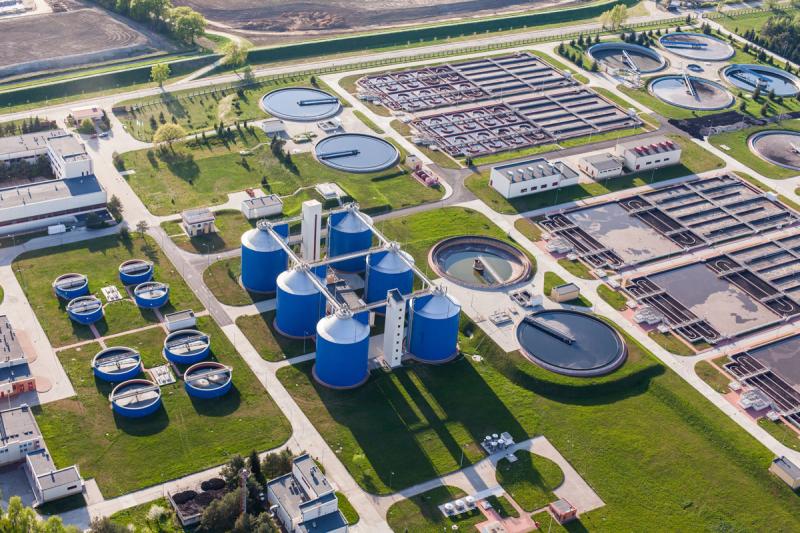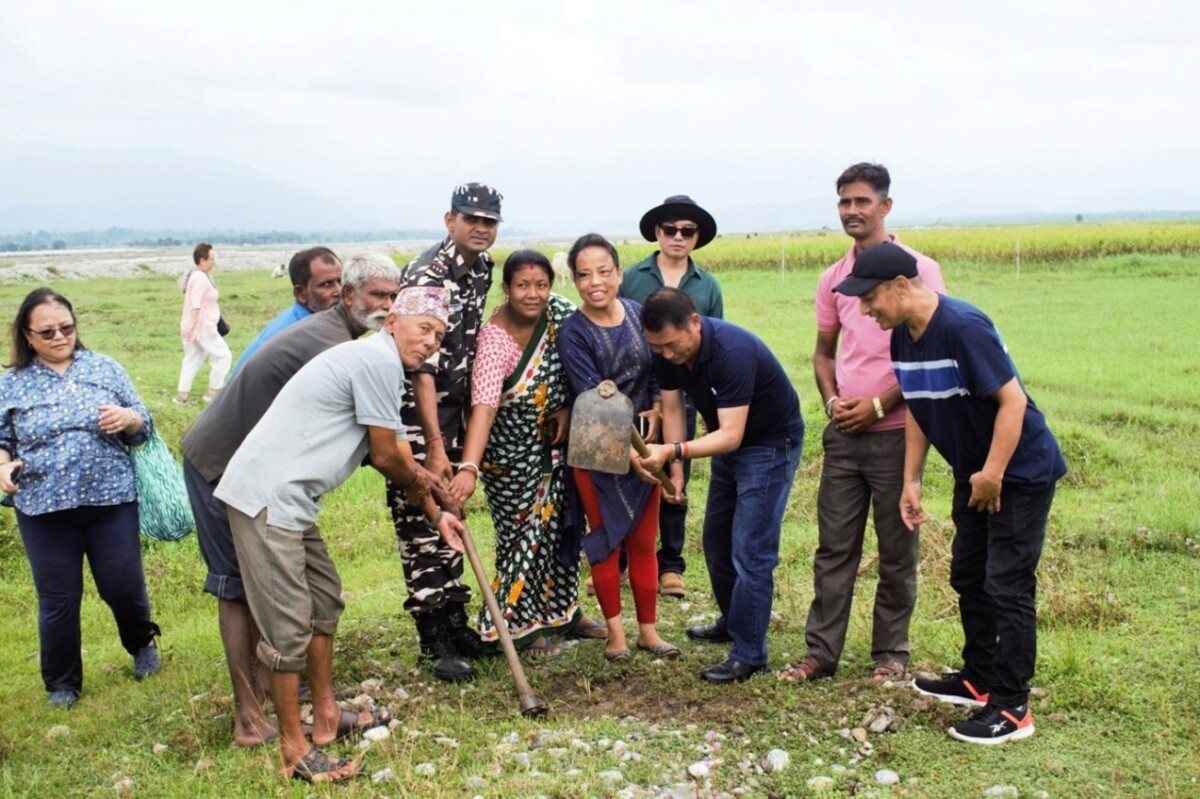Global Biological Wastewater Treatment Market: A Report on Sustainable Development Contributions
Executive Summary and Market Overview
The Global Biological Wastewater Treatment Market is projected to expand from USD 9.8 Billion in 2024 to USD 17.2 Billion by 2034, registering a Compound Annual Growth Rate (CAGR) of 5.8%. This growth is intrinsically linked to the global pursuit of the United Nations Sustainable Development Goals (SDGs), particularly SDG 6 (Clean Water and Sanitation). Biological wastewater treatment is a cornerstone technology for achieving SDG Target 6.3, which aims to improve water quality by reducing pollution and increasing safe reuse. In 2024, the Asia-Pacific (APAC) region dominated the market with a 48.2% share, valued at USD 4.7 Billion, reflecting its intensive efforts to address urbanization and industrialization challenges in line with SDG 11 (Sustainable Cities and Communities).
Biological wastewater treatment concentrates (BWTC)—the residual byproducts like sludge and biosolids—pose a significant management challenge. Advanced strategies for their treatment and disposal are critical for preventing environmental contamination and promoting a circular economy, thereby supporting SDG 12 (Responsible Consumption and Production). Industries such as chemicals, pharmaceuticals, and food processing are major generators of wastewater with high organic loads, necessitating efficient solutions. The adoption of technologies like Membrane Bioreactors (MBRs) is rising, driven by their effectiveness in treating complex effluents and enabling water reuse, which directly contributes to sustainable industrial practices under SDG 9 (Industry, Innovation, and Infrastructure).
Global policy frameworks are reinforcing this trend. The European Union’s Urban Waste Water Treatment Directive, which targets energy neutrality in treatment plants by 2040, aligns with SDG 7 (Affordable and Clean Energy) and SDG 13 (Climate Action). Similarly, initiatives like the U.S. EPA’s National Water Reuse Action Plan and China’s mandate to increase sewage reuse to 25% by 2025 underscore a worldwide commitment to sustainable water management and achieving the SDGs.
Key Report Takeaways
- Market Growth Projection: The market is forecast to reach USD 17.2 Billion by 2034, driven by global efforts to achieve SDG 6.
- Dominant Process: Aerobic Wastewater Treatment commanded a 62.8% market share, valued for its efficiency in meeting stringent water quality standards essential for SDG 6.3.
- Primary Wastewater Source: Municipal Wastewater constituted 56.9% of the market, highlighting the critical role of urban sanitation infrastructure in realizing SDG 11.
- Regional Leadership: The Asia-Pacific region leads with a 48.2% share (USD 4.7 Billion), indicating significant investment in sustainable infrastructure to manage rapid economic growth.
Analysis by Process
Aerobic Wastewater Treatment: A Key Enabler for SDG 6
In 2024, the Aerobic Wastewater Treatment segment held a commanding market share of 62.8%. Its dominance is attributed to high process efficiency in breaking down organic pollutants, making it a vital tool for municipalities and industries striving to meet the objectives of SDG 6 (Clean Water and Sanitation). The reliability of aerobic systems ensures compliance with increasingly strict environmental regulations. Technological advancements are enhancing the sustainability of these systems, reducing energy consumption and operational costs, which aligns with the principles of SDG 12 (Responsible Consumption and Production). As global urbanization and industrial activity intensify, the demand for robust aerobic treatment solutions is expected to grow, solidifying its role in building the resilient water infrastructure required for SDG 9 and SDG 11.
Analysis by Wastewater Type
Municipal Wastewater: Central to Sustainable Urbanization
The Municipal Wastewater segment accounted for a majority market share of 56.9% in 2024. This dominance is a direct consequence of global urbanization and the corresponding pressure on cities to provide adequate sanitation services, a core target of SDG 11 (Sustainable Cities and Communities). Effective municipal wastewater management is fundamental to protecting public health and urban ecosystems. Stricter governmental regulations on effluent discharge compel municipalities to adopt advanced biological treatment technologies. Furthermore, the growing emphasis on water reuse for non-potable applications like irrigation and industrial processes supports SDG 6.4 by increasing water-use efficiency and contributing to the circular economy, making this segment a critical focus for sustainable urban development.
Key Market Segments
By Process
- Aerobic Wastewater Treatment
- Activated Sludge
- Fixed-Bed Bioreactor (FBBR)
- Moving Bed Bioreactor (MBBR)
- Membrane Bioreactor (MBR)
- Biological Trickling Filters
- Anaerobic Wastewater Treatment
- Upflow Anaerobic Sludge Blankets (UASBs)
- Anaerobic Digesters
- Anoxic Wastewater Treatment
By Type of Wastewater
- Municipal Wastewater
- Industrial Wastewater
- Agricultural Wastewater
- Stormwater and Combined Sewer Overflows
- Chemicals
- Pharmaceuticals
- Others
Emerging Trends
Circular Resource Recovery: Advancing SDG 7 and SDG 12
A significant trend is the shift towards circular resource recovery from industrial wastewater, particularly in the food sector. This approach transforms high-concentration organic effluents from a disposal problem into a value-creation opportunity, directly supporting SDG 12 (Responsible Consumption and Production). Biological processes are central to this trend. For instance, anaerobic digestion of food processing wastewater can generate significant amounts of biogas (e.g., 8,300 m³ per day from pilot reactors), contributing to SDG 7 (Affordable and Clean Energy) and reducing the carbon footprint of facilities. Concurrently, the recovery of nutrients like phosphorus to produce fertilizers such as struvite supports SDG 2 (Zero Hunger) by promoting sustainable agriculture. International guidelines from the WHO, FAO, and UNEP, along with regulations like the EU’s Directive 2020/741, are creating a policy environment that incentivizes these SDG-aligned, circular-economy practices.
Market Drivers
Increasing Demand for Water Reuse and Recycling
A primary driver for the market is the escalating demand for water reuse and recycling, a critical strategy for addressing water scarcity and achieving SDG 6.4 (increase water-use efficiency). The agricultural sector, which consumes approximately 70% of global freshwater according to the FAO, and the food and beverage industry are under immense pressure to adopt sustainable water management. Biological wastewater treatment provides an environmentally sound and cost-effective method for treating water to a quality suitable for reuse. This not only conserves freshwater resources but also enhances operational resilience. Government policies, such as the EU Water Framework Directive and the U.S. EPA’s Clean Water State Revolving Fund (CWSRF), provide regulatory and financial incentives for industries to invest in treatment technologies that facilitate water recycling, accelerating progress towards a circular water economy.
Market Restraints
High Operational and Maintenance Costs
A significant restraint to the widespread adoption of biological wastewater treatment is the high operational and maintenance (O&M) expenditure. These costs, which include energy, chemicals, and skilled labor, can be a substantial barrier, particularly for small and medium-sized enterprises (SMEs) in sectors like food processing. This financial burden can impede progress towards universal access to adequate sanitation as envisioned in SDG 6.2 and hinder the development of inclusive and sustainable industrial infrastructure under SDG 9. While government funding programs like the EU’s European Investment Bank loans and the U.S. EPA’s CWSRF aim to alleviate this pressure, the high O&M costs remain a challenge that can slow the adoption of advanced treatment systems, thereby impacting the pace of achieving related SDG targets.
Market Opportunities
Adoption of Circular Economy Practices
The global movement towards a circular economy presents a major growth opportunity for the biological wastewater treatment market. By treating wastewater not as waste but as a source of valuable resources—water, energy, and nutrients—industries can significantly reduce their environmental footprint and enhance economic efficiency. This approach is central to SDG 12 (Responsible Consumption and Production). For water-intensive sectors like food and beverage, where the FAO notes that up to 30% of water can be wasted, implementing biological treatment for water recycling can drastically cut freshwater consumption. Policy frameworks like the EU’s Circular Economy Action Plan are creating powerful incentives for businesses to invest in technologies that enable resource recovery, positioning biological treatment as a key enabler of a sustainable and circular future.
Regional Insights
Asia-Pacific: Leading the Charge Towards Sustainable Water Management
In 2024, the Asia-Pacific (APAC) region solidified its position as the market leader, accounting for 48.2% of the global market with a value of USD 4.7 Billion. This dominance is propelled by the region’s urgent need to manage the environmental impacts of rapid industrialization and urbanization, aligning with SDG 9 and SDG 11. Governments across APAC are implementing stringent environmental regulations and investing heavily in water infrastructure to combat water scarcity and pollution, directly addressing the targets of SDG 6. The widespread adoption of biological treatment technologies like MBBRs and anaerobic digesters demonstrates the region’s strategic commitment to achieving its Sustainable Development Goals and building a resilient, environmentally sound future.
Key Regions and Countries Insights
- North America
- Europe
- Germany
- France
- The UK
- Spain
- Italy
- Rest of Europe
- Asia Pacific
- China
- Japan
- South Korea
- India
- Australia
- Rest of APAC
- Latin America
- Brazil
- Mexico
- Rest of Latin America
- Middle East & Africa
- GCC
- South Africa
- Rest of MEA
Key Players Analysis
Market leaders are advancing biological wastewater treatment technologies that directly contribute to the SDGs.
- Aquatech International: Specializes in high-efficiency systems like MBR and AnMBR that promote water reuse and energy efficiency. Its zero liquid discharge (ZLD) solutions are pivotal for industries aiming to achieve the goals of SDG 12, while its energy-efficient designs support SDG 7.
- Calgon Carbon: A leader in activated carbon adsorption technologies that remove harmful organic contaminants, directly contributing to improved water quality under SDG 6.3. Its global production and reactivation facilities support a circular economy model for filtration media.
- Condorchem Envitech: Provides customized biological and advanced oxidation processes for industrial clients, enabling them to meet stringent effluent standards and advance towards sustainable industrialization as per SDG 9.
- Veolia Environment SA: A global leader in optimized resource management, Veolia’s solutions for water, waste, and energy are integral to helping municipalities and industries achieve multiple SDGs, including SDG 6, SDG 7, SDG 11, and SDG 12.
- Xylem Inc.: Develops and provides water technology solutions that address the full water cycle. Its smart and efficient treatment systems help customers use water more effectively, supporting water conservation and management goals outlined in SDG 6.
Top Key Players Outlook
- 3M
- Aquatech International
- Calgon Carbon Corporation
- Condorchem Envitech SL
- DAS Environment Expert GmbH
- Dryden Aqua Ltd.
- Ecolab Inc.
- Entex Technologies
- Envirocare
- Huber SE
- Samco Technologies Inc.
- Suez Water Technologies & Solutions
- United Utilities Group plc
- Veolia Environment SA
- Xylem Inc
Recent Industry Developments
In 2024, Calgon Carbon expanded its U.S. production capacity of granular activated carbon (GAC) to over 200 million pounds annually. This expansion strengthens the supply chain for essential materials needed to achieve water quality targets under SDG 6.
In 2024, Aquatech International reinforced its market leadership by highlighting its global installation base, which treats over 1.6 billion gallons of water daily. This large-scale deployment of advanced MBR and MBBR technologies demonstrates the scalability of solutions crucial for meeting global water treatment needs and advancing SDG 6 and SDG 11.
Report Scope
Analysis of Sustainable Development Goals (SDGs) in the Article
1. Which SDGs are addressed or connected to the issues highlighted in the article?
The article on the Global Biological Wastewater Treatment Market addresses several Sustainable Development Goals (SDGs) by focusing on water quality, sustainable industrial practices, resource management, and urban infrastructure. The primary connections are:
- SDG 6: Clean Water and Sanitation: This is the most central SDG. The entire article revolves around treating wastewater from municipal and industrial sources to improve water quality, prevent pollution, and enable water reuse, which are core components of SDG 6.
- SDG 9: Industry, Innovation, and Infrastructure: The article discusses the industrial sector (chemicals, pharmaceuticals, food processing) as a major source of wastewater and highlights the adoption of innovative technologies like Membrane Bioreactors (MBRs) and anaerobic digesters. This relates to upgrading infrastructure and retrofitting industries to make them more sustainable.
- SDG 11: Sustainable Cities and Communities: The text emphasizes the treatment of municipal wastewater, driven by increasing urbanization. Managing urban wastewater effectively is crucial for reducing the environmental impact of cities and ensuring sustainable urban development.
- SDG 12: Responsible Consumption and Production: The article highlights the trend of a “circular economy,” focusing on resource recovery from wastewater, such as nutrients (phosphorus) and energy (biogas). This directly aligns with sustainable management of natural resources and reducing waste generation.
- SDG 7: Affordable and Clean Energy: The discussion on recovering energy from wastewater through processes like anaerobic digestion, which produces biogas, connects to the goal of increasing the share of renewable energy. The EU’s goal of achieving “energy neutrality” in wastewater plants is a direct link.
- SDG 13: Climate Action: By mentioning that energy recovery from biogas offers “carbon mitigation,” the article touches upon climate action by presenting a method to reduce greenhouse gas emissions.
2. What specific targets under those SDGs can be identified based on the article’s content?
Based on the article’s content, the following specific SDG targets can be identified:
-
SDG 6: Clean Water and Sanitation
- Target 6.3: “By 2030, improve water quality by reducing pollution, eliminating dumping and minimizing release of hazardous chemicals and materials, halving the proportion of untreated wastewater and substantially increasing recycling and safe reuse globally.” The article directly supports this by discussing technologies that treat wastewater containing organic matter, heavy metals, and pathogens. It also provides specific examples of reuse initiatives, such as China’s mandate to raise the proportion of treated sewage for reuse to 25% by 2025 and the U.S. National Water Reuse Action Plan.
-
SDG 9: Industry, Innovation, and Infrastructure
- Target 9.4: “By 2030, upgrade infrastructure and retrofit industries to make them sustainable, with increased resource-use efficiency and greater adoption of clean and environmentally sound technologies and industrial processes…” The article describes the adoption of advanced, efficient, and sustainable technologies like MBRs, anaerobic digesters, and microbial fuel cells by industries to manage their wastewater.
-
SDG 11: Sustainable Cities and Communities
- Target 11.6: “By 2030, reduce the adverse per capita environmental impact of cities, including by paying special attention to air quality and municipal and other waste management.” The article highlights that municipal wastewater is a dominant segment, driven by urbanization, and that effective treatment is essential for sustainable water management in cities.
-
SDG 12: Responsible Consumption and Production
- Target 12.2: “By 2030, achieve the sustainable management and efficient use of natural resources.” The trend of “circular resource recovery” in the food sector, which turns wastewater into resources like energy and fertilizer, is a direct example of this target.
- Target 12.5: “By 2030, substantially reduce waste generation through prevention, reduction, recycling and reuse.” The focus on water reuse and recycling, as well as the recovery of nutrients and energy from waste streams, directly contributes to this target.
-
SDG 7: Affordable and Clean Energy
- Target 7.2: “By 2030, increase substantially the share of renewable energy in the global energy mix.” The article mentions that anaerobic digestion of wastewater can produce significant amounts of biogas (a renewable energy source) and that the EU aims for energy neutrality in treatment plants.
3. Are there any indicators mentioned or implied in the article that can be used to measure progress towards the identified targets?
Yes, the article mentions several quantitative and qualitative indicators that can be used to measure progress:
- For Target 6.3 (Improve water quality and increase reuse):
- Indicator: Proportion of wastewater safely treated and reused. The article provides a specific metric: “China has mandated raising the proportion of sewage that must be treated to reuse standards to 25% by 2025.”
- Indicator: Reduction in pollutants. The article mentions “BOD₅ removal of over 95%” using microbial fuel cells, which is a direct measure of treatment effectiveness.
- For Target 9.4 (Adoption of clean technologies):
- Indicator: Investment in sustainable infrastructure. The article mentions the “U.S. Environmental Protection Agency (EPA) has awarded $6.4 million in research grants” and that the global market is expected to grow to “USD 17.2 Billion by 2034.”
- Indicator: Energy efficiency of technologies. The article cites a performance metric for MBR systems: “energy consumption performance as low as 1.75 kWh/m³.”
- For Target 12.2 & 12.5 (Resource recovery and waste reduction):
- Indicator: Rate of nutrient recovery. The article states that innovative systems are “recovering about 72% phosphorus by precipitation.”
- For Target 7.2 (Increase share of renewable energy):
- Indicator: Amount of renewable energy generated. The article provides specific data from pilot studies: “two 8,500 m³ reactors jointly produced approximately 8,300 m³ of biogas per day” and microbial fuel cells “generated up to 27 W/m³ of electricity.”
4. Summary Table of SDGs, Targets, and Indicators
| SDGs | Targets | Indicators Identified in the Article |
|---|---|---|
| SDG 6: Clean Water and Sanitation | Target 6.3: Improve water quality, reduce untreated wastewater, and increase recycling and reuse. |
|
| SDG 9: Industry, Innovation, and Infrastructure | Target 9.4: Upgrade infrastructure and retrofit industries with sustainable and clean technologies. |
|
| SDG 11: Sustainable Cities and Communities | Target 11.6: Reduce the adverse environmental impact of cities, including waste management. |
|
| SDG 12: Responsible Consumption and Production | Target 12.2 & 12.5: Achieve sustainable management of natural resources and reduce waste generation through recycling and reuse. |
|
| SDG 7: Affordable and Clean Energy | Target 7.2: Increase the share of renewable energy. |
|
| SDG 13: Climate Action | Target 13.2: Integrate climate change measures into policies and planning. |
|
Source: market.us







